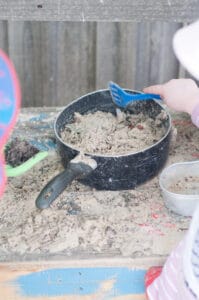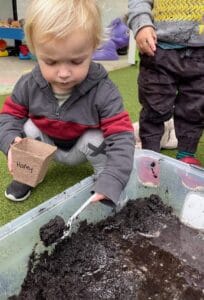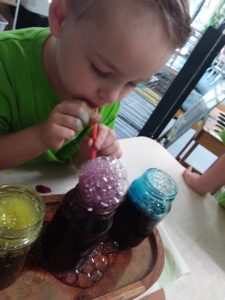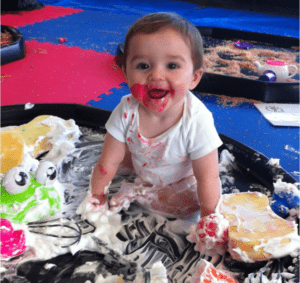The Benefits of Messy Play
for Kids
Let’s talk mud! And paint and glue, sand and feathers and all things parents and carers shudder to hear shouted.
There are several reasons why childcare educators employ messy play (or Sensory Play to the learned) – it develops senses, it improves motor skills, but perhaps the most important reason is because it’s just FUN!
Research tells us that having fun is a serious business! When a child is having fun, they’re learning to get along with others, expressing creativity and building on those oft mentioned ‘blocks’ of development.
So where to start?
A recent RCH poll found most parents (94%) recognise play is important for a child’s physical and brain development and many (58%) are keen to learn more about how to play with their child, however often parents and carers struggle to identify engaging activities to undertake with toddlers and pre-schoolers.
There are perceived barriers such as cost and risk, yet most might be surprised to find you don’t need much at all to get messy at home.


Some easy and affordable ideas are edible finger paint (recipe below) and home-made playdoh for your under 3‘s and sand or coloured rice play or planting of sprouts for Kinder age.

One of our favourites at Little Grasshopper’s is whisking and/or blowing bubbles in the sink or a cup – simply add a small amount of detergent, a drop or two of food dye and a straw (Woolworth’s have some inexpensive bamboo ones here) and you’re on your way to hours of silly, messy, noisy, unadulterated fun!
But let’s get serious for a minute, and chat about the why behind our love of mess.
When a child is able to get messy they are more likely to experience new textures, sensations and movements that lead to the improvement of whole hand and sensory development.
Whole hand development can be seen in very young children, for example, grasping objects, transferring objects from hands to mouth and between hands, clapping and banging objects together*. Sensory play works to improve these fine motor skills and encourage your child to begin or enhance their journey to handwriting and cognitive growth.
Paediatric Exercise Physiologist and Masters qualified Developmental Educator, Robyn Papworth encourages her parents and educators to enable their children to touch 5 to 10 things each day. By doing so you can build up their awareness and sensory skills of their hands. It is through the different sensory experiences they encounter in messy play that they form the foundation for future skills like using scissors and tying laces.
For more of Robyn’s insights take a browse of her website - Play Move Improve
So next time you’ve got a blank afternoon ahead of you or when tempers are frayed with the usual routine, take 10 minutes to set up some Messy Play, indoors or out. These tactile and fun activities will improve your child’s development of fine motor skills, and expose them to the sensory stimuli of smell, touch and movement, all fundamental to a holistic learning environment.
Oh and if your child is heading to Kinder or childcare, remember to pack an extra kit as a spare set of clothes can change the colour of a child’s day (and not just that new white t-shirt!).
EDIBLE FINGER PAIN RECIPE
INGREDIENTS
4 tablespoons cornflour
A little water from the tap
A full jug/kettle of boiling water
A large heatproof bowl
Your favourite whisk
METHOD
- In a large bowl put 4 heaped tbs of cornflour.
- Use a little water from the tap to mix to a smooth paste (like making custard or white sauce).
- Take your kettle of boiled water and slowly pour it into the bowl whisking briskly as you do. You need to move quickly as it will thicken as you pour in the water.
- Continue to pour and whisk until you get the texture you want. a little runnier for easel painting and craft but thicker for finger painting. By adding more or less water you can reach the texture you prefer. Now you have your paint base (and a good collage/papier-mache glue to boot!)
- Add a few drops of non-toxic food colouring (or a little sprinkle of edicol powdered dye) – kids love to see the few drops in the centre of white spread to the entirety so let them get involved in this step!
- Get Messy!

